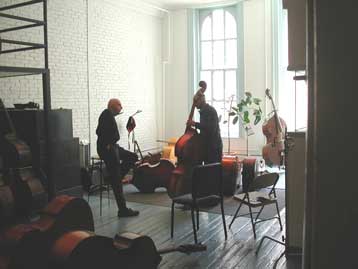
This page features updated FAQs. If you do not find the answer to your question here, please contact us by emailing or using the form provided here. We will investigate and respond as promptly as we can.
Realist FAQ
Generally, The Realist does not affect the acoustic sound of your instrument. The element is slim and conforms the top of your instrument when pressure is applied to it by the weight of the bridge. We conducted a 'blindfold test' and found that players were consistently unable to detect whether the pickup was on or off the instrument.
The Realist is a high impendence transducer. The Realist is rated at 10mg ohms.
It is not necessary to use a preamp with The Realist. The Realist simply amplifies the acoustic sound of your instrument without coloring it. The benefits of a Preamp are that they can make up for shortcomings in your instrument's acoustic sound. -They can boost the highs or the lows or fill in some mids that might not be present enough. No matter how high the quality of your components is, more links in the chain from your instrument to the speaker will change the original texture slightly.
Feedback is an ever-present problem when amplifying any instrument. Feedback is a still bigger problem when amplifying an acoustic instrument because of the fact that the resonant qualities of its body make it more likely to be stimulated by the sound from the speaker. When the instrument is stimulated in this way, the pickup then retransmits this signal to the amp. The cycle of retransmission causes feedback.
We recommend, when playing at louder volumes, you make sure that your instrument is as far as it can be from the speakers that are projecting your signal. Sometimes, simply turning your instrument away from the speaker while playing helps to eliminate feedback. Another recommendation would be to use a headphone monitor so that you will be able to have the speaker far away from you and still have the ability to monitor yourself. Another technique is to wedge high-density foam (a Nerf football) between the tailpiece and top and into the f-holes to limit extra-sonic vibrations.
There is a one-year warrantee that covers The Realist on parts and workmanship.
There are many differences between The Realist and other pickups. The first, most apparent difference is where the transducer is placed. -The Realist 'reads' off of the top of the instrument where the tone color of your instrument is created and thus produces a signal that is comprised of the same textures that the instrument generates acoustically. The result is a very faithful representation of the sound that acoustic musicians spend so much time on.
The Realist uses a standard quarter-inch jack used by electric and acoustic instruments all over the world. Cables and connections are commonly available. The Realist for Violin and for Viola are also available with a mini (1/8') jack. A 1/4'-to-mini cable is included in the box with transducers equipped with the mini-jack.
No special instructions here. Players of all instruments have found that recording engineers absolutely love The Realist Transducer for its superior acoustic fidelity and its elegant simplicity.
The Realist does not significantly change your string heights. If you feel like the heights of your strings are too high after you have installed The Realist, we suggest you wait for a few days before adjusting your bridge. The Realist compresses during the first few hours it is installed and, in the end, will likely be too thin to feel after it has finished settling.
Up to a year after your purchase of The Realist, problems should be forwarded to the dealer from whom you bought your pickup. They will be able to handle replacement under the warrantee. After the first year, contact us regarding repair and replacement (see FAQ warrantee question).
We recommend that rosin be used (powdered or not) under your cello's bridge feet if you have a problem with slipping. Generally, this has not been a problem after The Realist has been on the instrument for a couple of days. But if you're having a problem with slipping, the rosin should work.
The jack should be placed on the bass side of the body, below the c-bout.
Yes, the heights are raised approximately .25 mm. We recommend that you either cut your bridge down to the desired height or cut another bridge that is a little lower. Many players simply play their violin with a little higher string height or have a separate violin for playing through an amplifier.


